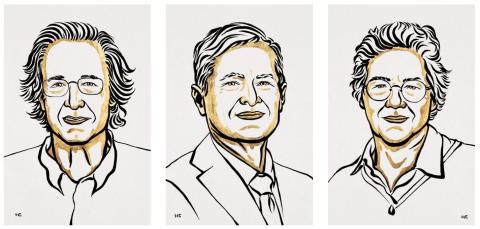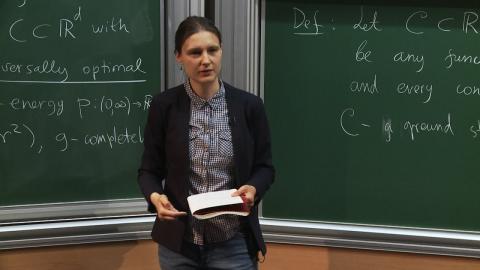Reactions: Nobel Prize in Chemistry to Bawendi, Brus and Ekimov for discovering quantum dots
The Royal Swedish Academy of Sciences has awarded the Nobel Prize in Chemistry 2023 to Moungi G. Bawendi, Louis E. Brus, and Alexei I. Ekimov "for the discovery and synthesis of quantum dots." Quantum dots are tiny nanoparticles that diffuse their light from televisions and LED lights, and can also guide surgeons when removing tumor tissue, among many other applications.
David Sánchez - Nobel Química 2023 EN
David Sánchez
Researcher at the Institute of Interdisciplinary Physics and Complex Systems (IFISC-CSIC-UIB)
Quantum dots are one of the most important systems in nanoscience. They are artificial structures, built in the laboratory, that are capable of confining electrons in regions of miniscule size, thousands of times smaller than the thickness of a human hair. In nature, electrons are confined within atoms, but manipulating them is difficult and expensive. Thanks to quantum dots, electrons can be trapped to make their study much easier. Hence quantum dots are called 'artificial atoms'.
Since their creation a few decades ago, quantum dots have not only served as the basis for technological applications (e.g. televisions) but have allowed us to explore fascinating physico-chemical phenomena, helping us to understand how quantum particles behave under controlled conditions.
Mora - Nobel (EN)
Iván Mora Seró
Professor of Applied Physics
I value it very positively for materials scientists because it is a Nobel Prize that focuses on new materials that do not exist in nature and in which we design the properties. Each material has its own properties. We make these materials very small, in the form of quantum dots. By controlling, for example, their size, we control the light they emit, i.e. we control their properties. We make materials to size and this has opened the way for many other materials: quantum dots, nanowires, nanoplatelets.... A world in itself where we have very perfect crystals, very small crystals that allow us to make them with that degree of perfection, to improve their properties.
With surface control we can take advantage of the properties of these materials. For example, they emit very good light and color-controlled light and that is why quantum dots are now used in televisions, because they improve the quality of the devices that were there until now.
Basically the main interest is that it has opened up a new field in which there is a lot of science because they are tailor-made materials.
Enrique Palomares - Nobel Química 2023 EN
Enrique Palomares
Director of the Catalan Institute for Chemical Research (ICiQ)
Quantum dots are materials that are already applied in optoelectronics-related technologies, such as QLED TV screens. Beyond technological applications, they have important applications in biomedicine because of their advantages over classical organic dyes used to colour parts of cells. Quantum dots allow much higher light intensities. By controlling their size, you can control where you want them to emit and even go from blue, near ultraviolet, to infrared emissions, which has been exploited for night vision technology.
It is a very versatile material, ranging from applications in infrared solar cell energy to biology. In addition, synthesis processes using organic and inorganic precursors have enabled a large number of groups to synthesise these materials in the laboratory. It is not as specific a technology as silicon, which requires expensive and sophisticated facilities. Quantum dots can be synthesised in the laboratory using selenium, cadmium or even zinc oxide precursors. This award reinforces the idea that there are no technological applications without fundamental research.
Pelayo -Nobel (EN)
Pelayo García de Arquer
Head of the Research Group at the Institute of Photonic Sciences (ICFO)
Semiconductor materials, such as silicon, have enabled transformative revolutions in fields from computing and electronic devices to lasers, communications and energy.
Quantum dots are a special type of nanostructured semiconductors where the interaction of electronic charges is highly confined, on nanometer scales. Such confinement allows interactions only at certain energy levels, similar to the different notes of a stringed instrument. This allows manipulation of their physicochemical, optical and electronic properties by controlling the size of these nanoparticles, resulting in a family of semiconductors with a rich and wide range of properties that are easily tunable beyond conventional materials. A clear example is the strong interaction of quantum dots with light, which can be manipulated to absorb and emit light of different colors (along different wavelengths) and in a very pure way.
Bawendi, Brus and Ekimov were the pioneers in the discovery of routes to synthesize these materials, as well as in the study of their properties. Thanks to their seminal work, today we can fabricate these materials by controlling their properties with great precision, down to the atomic scale. This has led to several breakthroughs with impact beyond science.
Quantum dots have found many applications. The programmable reactivity of their surfaces, combined with their optical properties, allows the realization of optical probes with chemical and biological specificity. Their electro-optical properties have enabled the development of laser light sources, displays, sensors and solar panels in a way that would not be possible with traditional materials.
This is a well-deserved recognition - it's about time! My sincere congratulations to the award winners and to all the people who have enabled (and will continue to pursue) historic advances in this field.
María José Ruedas - Nobel Química EN
María José Ruedas Rama
Professor of the Department of Physical Chemistry in the Faculty of Pharmacy at the University of Granada
Quantum dots are particles so small that their properties are determined by phenomena of a quantum nature. One of the most interesting characteristics is their luminescence, since when excited they are capable of emitting light of different colours depending on their size.
Quantum dots are nowadays of great importance in nanotechnology. Among some applications, they can be used in the preparation of solar panels, in screen and television lighting systems based on QLED technology and, of course, in biomedicine, as they allow images to be obtained at the intracellular level that can be very useful in the diagnosis and treatment of diseases such as cancer.
This is a well-deserved recognition of the great impact of quantum dots in different areas of nanotechnology.
Josep Hilari Planelles - Nobel Química EN
Josep Hilari Planelles Fuster
Professor of Physical Chemistry at the Universitat Jaume I of Castellón
The advent of quantum dots has created a new realm in fundamental physics: that of quantum dots or artificial atoms. In contrast to the little more than 100 natural atoms, there is an a priori infinite number of these artificial atoms, which can be made to order, thus adjusting their properties, both in the fabrication process and through appropriate external sources of confinement. Despite the vast array of applications of quantum dots developed in recent decades, it is foreseeable that these are only a small fraction of the applications they will have in the future.
Gloria Platero - Nobel Química 2023 EN
Gloria Platero
Research Professor leading the research group New platforms and nanodevices for quantum simulation and computing of the Madrid Institute of Materials Science (CSIC)
Quantum dots, or artificial atoms, are zero-dimensional structures that follow the laws of quantum physics. There are different types of quantum dots, depending on their implementation in the laboratory, and they have important applications in quantum technologies, such as quantum computing, medicine or energy. Quantum dots formed by nano-sized crystals in a semiconductor material can be designed in such a way that, by controlling their size, the frequency of the light they emit can be controlled simultaneously, which has important implications in optoelectronics and bioimaging. How to synthesise these nanocrystals and how to control their size, and thus their properties, has led to the 2023 Nobel Prize in Chemistry being awarded to Bawendi, Brus and Ekimov.


